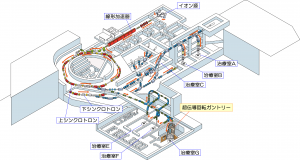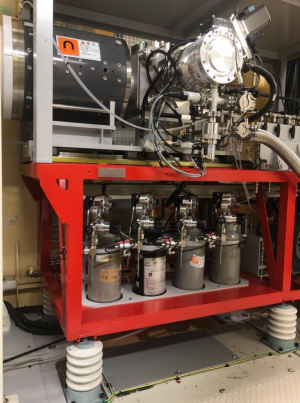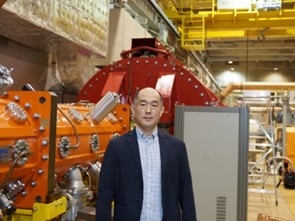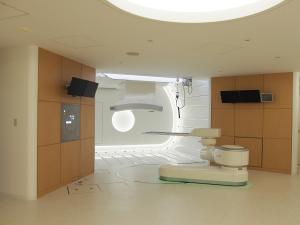Operation of Heavy-Ion Medical Accelerator Complex (HIMAC), and Related Research and Development of Heavy-Ion Accelerator
Radiotherapy using energetic carbon beams from the Heavy Ion Medical Accelerator in Chiba (HIMAC) has been carried out at the National Institutes of Quantum Science and Technology (QST) since June 1994. Radiotherapy has been made during the daytime, while heavy-ion beams are being provided for research use at night. The HIMAC operation section is responsible for the operation and maintenance of the HIMAC accelerators. As it has been more than 30 years since HIMAC was in operation, we will systematically maintain, repair, and upgrade all equipment for stable operation of the HIMAC accelerator.
In the research field of the heavy-ion radiotherapy, new irradiation techniques, such as multi-ion therapy, have been developed for advanced radiation therapy. To realize these new irradiation techniques, the HIMAC accelerators need to be accordingly upgraded. The HIMAC operation section is also in charge of improving the performance of the HIMAC accelerators, as well as developing the new ion source and beam transport lines for the quantum scalpel project.
Heavy-ion Medical Accelerator, HIMAC and Heavy-ion Radiotherapy System
HIMAC (Heavy Ion Medical Accelerator in Chiba) consists of a synchrotron accelerator for accelerating heavy-ion beams, including carbon-ions, to an energy of 800 MeV per nucleon, and a treatment room for irradiating patients. The treatment room is equipped with a rotating gantry that can irradiate the patient with carbon-ion beams from any angle of 360 degrees using superconducting technology. A high-speed three-dimensional scanning device that can irradiate complex-shaped tumors in a short time is also installed. Both are aiming to reduce the physical burden on the patient and improve the treatment effect .

Left: Schematic drawing of HIMAC, Right: Treatment Room G(rotating gantry port)

New electron cyclotron resonance ion source (ECRIS)
This ECRIS can provide highly charged ions of helium, carbon, oxygen, and neon, and can quickly switch ion species for multi-ion therapy. Since permanent magnets are employed to generate the plasma confinement magnetic field, we could design the compact ion source.
Member

Iwata Yoshiyuki Director
- Katagiri Ken Section Manager
- Sakamoto Yukio Principal Technical Staff
Concurrent member
- Sato Shinji Section Manager
- Sugiura Akinori Principal Technical Staff
- Fujita Takashi Senior Expert
Selected Publications
- Katagiri K.,Iwata Y.,Shirai T.: Bias disk boost technique for pulsed-operation electron cyclotron resonance ion sources.Nuclear Instruments and Methods in Physics Research Section A Accelerators,1069 169948,(2024).
- Iwata Y.,Shirai T.,Mizushima K.,Matsuba S.,Yang Y.,Noda E.,Urata M.,Muramatsu M.,Katagiri K.,Yonai S.,Inaniwa T.,Sato S.,Abe Y.,Fujimoto T.,Sasano T.,Shiraishi T.,et al.: Design of a compact superconducting accelerator for advanced heavy-ion therapy.Nuclear Instruments and Methods in Physics Research Section A Accelerators,1053 168312,(2023)
- Muramatsu M.,Ouchi F.,Suzuki T.,Takahashi K.,Sasano T.,Shiraishi T.,Nomura S.,Takahashi N.,Kato Y.,Katagiri K.,Mizushima K.,Iwata Y.,Inaniwa T.,Kitagawa A.:Concept design of new compact electron cyclotron resonance.Journal of Physics:Conference Series,2244 012094,(2022)
- Katagiri K.,Kawamura K.,Wakui T.,Muramatsu M.,Hayashizaki N.:Design study of compact EBIS for light-ion production using low-energy hollow electron beams.Nuclear Instruments and Methods in Physics Research Section A Accelerators Spectrometers Detectors and Associated Equipment ,987 164837,(2021)

